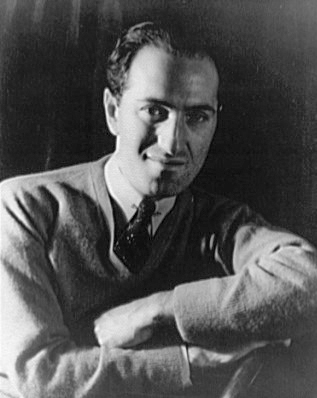

Personal Data
Dates: 1898-1937
Born: Brooklyn, New York
Residences: New York, Hollywood
George Gershwin
The music of George Gershwin melds classical and popular styles with the use of jazz idioms. The music has been aptly described as the embodiment of musical Americana.
George Gershwin ( born “Jacob Gershwine”) grew up in a poor immigrant Jewish neighborhood in the lower east side of Manhattan. His parents had emigrated from Ukraine in 1891. George was the second of four children, which included his older brother Ira (1896-1983), Arthur (1900-1981), and Frances (1906-1999).
When the family acquired an upright piano in 1910, George quickly taught himself to play. In 1912 he began studying more formally and learned works of Chopin, Liszt, and Debussy. He studied theory and composition, but somehow never became truly proficient at reading music.
Gershwin Timeline
Tin Pan Alley
Gershwin’s piano performance skills were considerable, however. In 1914 (only 16 years old) he became a song-plugger on Tin Pan Alley. Music publishers had their offices on West 28th Street in Manhattan. The block acquired the name Tin Pan Alley because of the cacaphony coming from open windows as multiple song-pluggers like Gershwin played tunes by composers hoping to land a publishing deal.
Gershwin himself achieved his first publication in 1916 of the song When You Want ‘em, you can’t get ‘m, when you get ‘me, you don’t want ‘em. (1916).
Swanee (1919)
In 1919, Gershwin had his first big hit. The song Swanee, with lyrics by Irving Caesar, was written for a New York revue. It gained popularity when, in 1920, Al Jolson heard Gershwin play it at a party. Jolson put it into his show and recorded it in 1920. It moved to number one on the charts and sold a million sheet music copies and two million records.
Listen to Al Jolson’s 1920 recording:
(You must be logged into the Circle of Scholars to view the rest of this page.)
